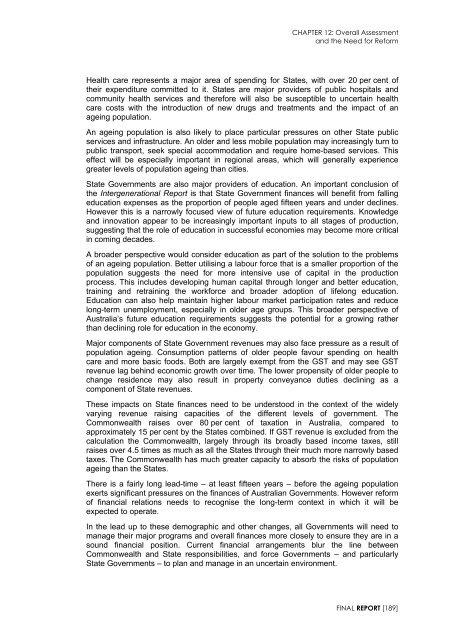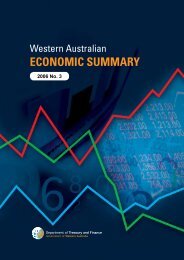Garnaut Fitzgerald Review of Commonwealth-State Funding
Garnaut Fitzgerald Review of Commonwealth-State Funding
Garnaut Fitzgerald Review of Commonwealth-State Funding
Create successful ePaper yourself
Turn your PDF publications into a flip-book with our unique Google optimized e-Paper software.
CHAPTER 12: Overall Assessment<br />
and the Need for Reform<br />
Health care represents a major area <strong>of</strong> spending for <strong>State</strong>s, with over 20 per cent <strong>of</strong><br />
their expenditure committed to it. <strong>State</strong>s are major providers <strong>of</strong> public hospitals and<br />
community health services and therefore will also be susceptible to uncertain health<br />
care costs with the introduction <strong>of</strong> new drugs and treatments and the impact <strong>of</strong> an<br />
ageing population.<br />
An ageing population is also likely to place particular pressures on other <strong>State</strong> public<br />
services and infrastructure. An older and less mobile population may increasingly turn to<br />
public transport, seek special accommodation and require home-based services. This<br />
effect will be especially important in regional areas, which will generally experience<br />
greater levels <strong>of</strong> population ageing than cities.<br />
<strong>State</strong> Governments are also major providers <strong>of</strong> education. An important conclusion <strong>of</strong><br />
the Intergenerational Report is that <strong>State</strong> Government finances will benefit from falling<br />
education expenses as the proportion <strong>of</strong> people aged fifteen years and under declines.<br />
However this is a narrowly focused view <strong>of</strong> future education requirements. Knowledge<br />
and innovation appear to be increasingly important inputs to all stages <strong>of</strong> production,<br />
suggesting that the role <strong>of</strong> education in successful economies may become more critical<br />
in coming decades.<br />
A broader perspective would consider education as part <strong>of</strong> the solution to the problems<br />
<strong>of</strong> an ageing population. Better utilising a labour force that is a smaller proportion <strong>of</strong> the<br />
population suggests the need for more intensive use <strong>of</strong> capital in the production<br />
process. This includes developing human capital through longer and better education,<br />
training and retraining the workforce and broader adoption <strong>of</strong> lifelong education.<br />
Education can also help maintain higher labour market participation rates and reduce<br />
long-term unemployment, especially in older age groups. This broader perspective <strong>of</strong><br />
Australia’s future education requirements suggests the potential for a growing rather<br />
than declining role for education in the economy.<br />
Major components <strong>of</strong> <strong>State</strong> Government revenues may also face pressure as a result <strong>of</strong><br />
population ageing. Consumption patterns <strong>of</strong> older people favour spending on health<br />
care and more basic foods. Both are largely exempt from the GST and may see GST<br />
revenue lag behind economic growth over time. The lower propensity <strong>of</strong> older people to<br />
change residence may also result in property conveyance duties declining as a<br />
component <strong>of</strong> <strong>State</strong> revenues.<br />
These impacts on <strong>State</strong> finances need to be understood in the context <strong>of</strong> the widely<br />
varying revenue raising capacities <strong>of</strong> the different levels <strong>of</strong> government. The<br />
<strong>Commonwealth</strong> raises over 80 per cent <strong>of</strong> taxation in Australia, compared to<br />
approximately 15 per cent by the <strong>State</strong>s combined. If GST revenue is excluded from the<br />
calculation the <strong>Commonwealth</strong>, largely through its broadly based income taxes, still<br />
raises over 4.5 times as much as all the <strong>State</strong>s through their much more narrowly based<br />
taxes. The <strong>Commonwealth</strong> has much greater capacity to absorb the risks <strong>of</strong> population<br />
ageing than the <strong>State</strong>s.<br />
There is a fairly long lead-time – at least fifteen years – before the ageing population<br />
exerts significant pressures on the finances <strong>of</strong> Australian Governments. However reform<br />
<strong>of</strong> financial relations needs to recognise the long-term context in which it will be<br />
expected to operate.<br />
In the lead up to these demographic and other changes, all Governments will need to<br />
manage their major programs and overall finances more closely to ensure they are in a<br />
sound financial position. Current financial arrangements blur the line between<br />
<strong>Commonwealth</strong> and <strong>State</strong> responsibilities, and force Governments – and particularly<br />
<strong>State</strong> Governments – to plan and manage in an uncertain environment.<br />
FINAL REPORT [189]

















